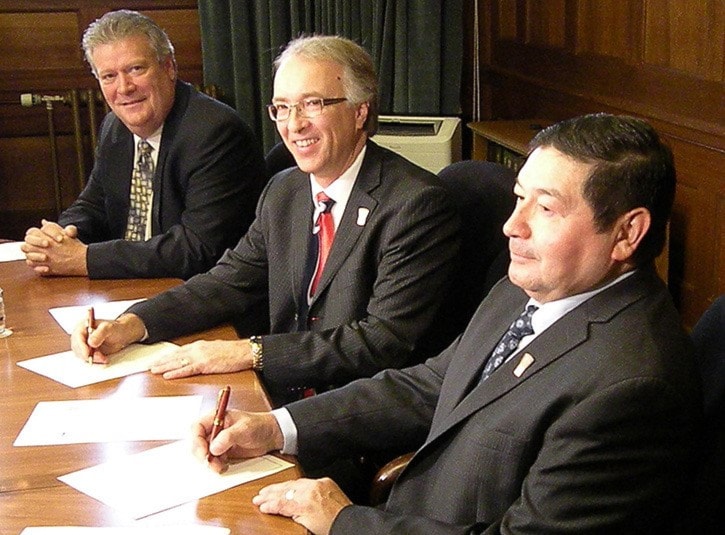FIRST Nations stand to earn millions from having natural gas pipelines cross over their traditional territories from northeastern gas fields to liquefied natural gas (LNG) plants on the coast.
So far the province is offering $10 million per year for each of four natural gas pipeline routes now being planned to be divided up among applicable First Nations once those pipelines are in operation.
It’s also offering signing bonuses and pipeline construction milestone payments to those same First Nations.
Speaking last week, provincial natural gas development minister Rich Coleman said the provincial money is intended as one way for First Nations to benefit from what could be a significant industrial base for decades.
“The First Nations side is coming along very well,” said Coleman of the provincial monetary package being offered as part of the province’s overall LNG strategy.
The Nisga’a Nation, using its 2000 land claims agreement with the federal and provincial governments as a foundation, has already signed onto one route – Prince Rupert Gas Transmission owned by TransCanada Pipelines, a 900 km 48-inch pipeline to feed PacificNorthwest LNG, a facility Malyasian-owned Petronas wants to build on Lelu Island near Prince Rupert.
The Nisga’a are to receive $1.014 million right away and $5.07 million divided into two equal instalments – one when construction of the pipeline has begun and the second when the first gas starts to flow.
These payments are in addition to a separate benefits agreement the Nisga’a Nation has signed with TransCanada and separate to any tax revenues the Nisga’a would receive from the pipeline as it crosses through Nisga’a Lands.
Provincial information indicates the same basic package of a signing bonus and construction milestone payments as accepted by the Nisga’a is being offered to each and every First Nation along the four pipeline routes now being planned.
Coleman did stress that other than the signing bonuses being offered, no money will be paid out until the province starts receiving taxation revenue from LNG developments.
“What these are are back-end loaded agreements,” said Coleman. “As the revenue comes in, that’s what we’ll then share.”
At last count, there are more than 20 First Nations, for example, who have traditional territory along the Prince Rupert Gas Transmission route.
Citing confidentiality of ongoing negotiations with First Nations, provincial government officials would not release how much money each of the First Nations would receive for construction payments.
But if the Nisga’a are to receive $6 million for the 83 kilometres of the 900 kilometre pipeline which would pass through their core lands, the overall dollar amount would be substantial.
The other three pipeline projects to which payments would apply to northern First Nations are the Westcoast Connector corridor of two 48-inch pipelines Spectra Energy wants to build to feed a BG Group LNG plant called Prince Rupert LNG on Ridley Island, the CoastalGas Link pipeline for the Canada LNG project at Kitimat and the Pacific Trail Pipeline project for another LNG plant at Kitimat called Kitimat LNG.
First Nations who wish to receive a signing bonus must sign a benefits agreement by June 30, 2015 or risk losing their eligibility, says the province.
“[But] they would still be eligible for construction milestone payments,” adds the provincial information. June 30, 2015 is also a key date to decide on how to divide up the $10 million being offered in annual payments for each of the pipelines which go into service.
For now the province is leaving that up to the First Nations.
“However, if no agreement can be made between eligible First Nations by June 30, 2015, the province will decide on allocation,” reads the provincial background information.
The provincial information did not explain how it exactly reached the $10 million annual benefit amount.
“Some First Nations expressed concern that the province had come up with its own allocation of benefits and that the allocation chosen by the province didn’t meeting their expectations,” the provincial information package continued.
“The $10 million in annual ongoing benefits per proposed natural gas pipeline project was reached following further discussions with eligible First Nations.”
The money for the Pacific Trail Pipeline project is to be handled not as a direct payment to First Nations. Instead it is being funneled through an existing partnership made up of 15 First Nations along that pipeline route and it is up to the partnership to decide how the money will be divided.
